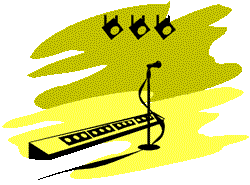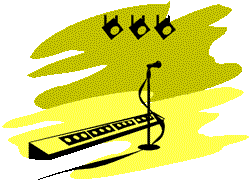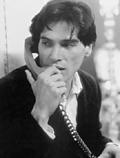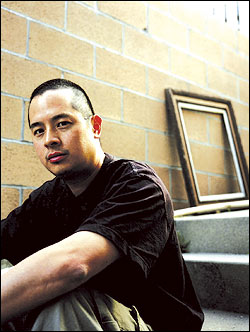The idea I had for covering South by Southwest 2005, in Austin, Texas, was simple: Try to see (and write about) artists I hadn’t seen before.
This would have been easier on Wednesday, March 16, if two of the three showcases I was most interested in didn’t belong to local labels. Sub Pop’s lineup at Emo’s boasted the A Frames (20 superb minutes I couldn’t describe better than Yancey Strickler’s piece, to the left of this column) and Portland’s Thermals, whose first three songs sounded as brisk and on target as on my previous viewings and listenings.
A little after 11 p.m., three colleagues and I took a cab to the Back Room, an off-the-path suburban bar whose walls were filled with metal posters and whose stage was filled with rappers.
We got there in time to see Philadelphia DJ Chops play to a full, nonchalant house. Since we were in Texas, it only seemed right to party with the Houston-themed evening—the primary sound was bottom-heavy Southern rap (which the Back Room’s crappy sound system didn’t do justice to), and the vibe was mellow enough.
Good thing, since apart from a lively 10-minute appearance by local hero Paul Wall, a white dude whose heavy buzz suggests he might become a Southern Eminem, the evening dragged on pretty uneventfully.
The artist we really wanted to see was Houstonite Devin the Dude, he of the laconic flow, everyman persona, and the most deeply pleasurable hip-hop album of the past year (2004’s To Tha X-Treme).
Devin was set to go on at 12:30, but by the time 12:45 arrived and he didn’t, we’d lost our patience and found a cab back to party central, the middle of the downtown club district. I hustled into Maggie Mae’s just in time for U.S.E. Having written about them in this space before, I’ll briefly note that the band elicits the same fervor outside its home base as it does in Seattle. I didn’t recognize any of the folks near the front who were dancing so hard they were nearly moshing at a few points. I’ll also bask in the fact that three people I’d recommended the show to were all as ecstatic as I was when it was over.
Thursday, March 17, was another good day for basking—for one thing, the sun came out after a cloudy Wednesday. Appropriately, the first band I caught was Stars at Emo’s, one of a handful of groups riding a wave of dubious hype surrounding Montreal-based indie pop this year. Stars, though, bypass the hype by being charming; they’re pretty and jangly, and they gain momentum—meaning, I guess, that they speed up a lot. (I am, it should probably be noted, a sucker for jangle that speeds up.) When the male lead singer ended a sentence with the phrase “guaranteed good reviews,” though, nobody laughed, probably because most of the folks in the audience had already filed theirs.
After an abortive attempt to get into what was by all accounts a thoroughly botched listening party for the new Gorillaz album (after spending 20 minutes in line, I suddenly realized that I’d just spent 20 minutes in line to hear the new Gorillaz album) and an even more abortive attempt to eat (after I spent 25 minutes being ignored, a man in a suit walked in and the wait staff were on him like he was the moon and they were Neil Armstrong), I hiked back to Emo’s for Tegan and Sara, who were the very definition of serviceable.
Better were the Kills, at Red Eyed Fly (a party sponsored by SW owner Village Voice Media). “Sorry it’s daylight,” said guitarist Jamie Hince. Well, maybe if you weren’t wearing a black scarf around your neck in the middle of a Texas spring you wouldn’t feel that way, dude. Still, the duo—Hince’s guitar and occasional backup vocals, Allison Mosshart’s yowl and occasional guitar, and a drum machine—rocked plenty, though it wasn’t hard to understand what one English publicist meant when during one number he asked, “Is this ‘Barracuda’?”
After American Analog Set back at Emo’s (I saw them incidentally, which fits their music), followed by dinner, I made my way to Friends for the Like Young (anxious, muffled, bleh) and St. Paul, Minn.’s Hockey Night. Willamette Week music editor (and SW contributor) Mark Baumgarten referred to them as “my U.S.E.,” which was good enough. So was the band: indie rock that evokes its early-’90s heyday, before its practitioners got scared of their own post-Nirvana shadow. They were also funny: “This song is about tubing,” said one of the two drummers, “which is something I would love to do right now.”
After an ineffectual wait to get into M.I.A. at Elysium, my revolving crew and I landed at the Whiskey Bar for two Brooklyn bands: Turing Machine, whose sandstorm guitars and snarling breakdowns were effective and limited in equal proportions—great soundtrack music, but not necessarily for a bar—and the Hold Steady, the second great band in a row featuring Craig Finn and Tad Kubler. Expanded to a quintet thanks to the addition of keyboardist Franz Nicolay, and sporting a different drummer than appeared on last year’s brilliant The Hold Steady Almost Killed Me, the new lineup swung harder and seemed freer onstage than when it formed two years ago.
Opening with Almost‘s “Positive Jam,” they seemed shaky but nice until the third song, the lead track from the forthcoming Separation Sunday, after which everything sounded about six times bigger and far more detailed. The sooner this band comes to Seattle, the happier this city will be.
At the Ritz, Death From Above 1979 surprised me—I didn’t know Lightning Bolt were allowed to go pop. But the big finale was Queens of the Stone Age, playing at an Entertainment Weekly–sponsored “private” party in an old airplane hangar. With Mark Lanegan onstage for about half of it and Josh Homme in more varied and commanding voice than ever, as well as a skintight revamped band and exceptional new material, the only thing that could have topped it was a guy looking like Dolph Lundgren in a straight-to-Cinemax Matrix rip-off with a giant red Batman insignia tattooed on his chest. Needless to say, top it he did.
The weekend was blurrier. Friday’s Spin magazine party also featured the Hold Steady, followed by more hyped performances. Louis XIV, the San Diego group, were so bad—and so blatantly formed in the Strokes’ and Rapture’s wake—I started calling them nü-Menswear, after the hapless Britpop combo who followed a VH1 Behind the Music–style trajectory before they’d even written an album’s worth of songs. They’re sexist jerks, too. The Futureheads were terrific, and Bloc Party followed a good EP and a lame album with a performance that split the difference—they sounded worried and good.
I skipped Spin party headliners the New York Dolls—two original members, including singer David Johansen, with some ringers, who were by most accounts quite good (one observer nailed it: “songs I’ve loved since I was a kid played well”)— to run over to Beer Land and see Coachwhips. I caught half a song before the set was over—which, if you’re familiar with the buzzy rush of the ‘Whips’ 20-minute albums and hornet-in- a-hatbox sonics, means it was perfect. Later on, Japanese psych-rockers DMBQ were woolier and more expansive than their album, which suits drug music.
Saturday was even better. Schoolyard Heroes and U.S.E. at the Long Branch Inn got me going—but not, to my utter surprise (and delight), as much as Buck 65 at Emo’s.
The usual who-cares indicators—white rapper (from Nova Scotia, no less) beloved of non-hip-hop critics, beats aren’t much, lacks flow—flew out the window, thanks equally to the guy’s charisma and his pen. Buck 65—real name Rich Terfry—”gestures like a diva,” as Village Voice SXSW blogger (and SW contributor) Amy Phillips put it. A couple times he tossed glitter into the air, Tom Waits–style (his scratchy voice is very Waits-y as well); he got big laughs at one point by underlining it: “You know what they call that?” he asked. “Razzle-dazzle.”
His couplets knocked me over. “Riding the elevator/With John the Revelator” would be a hook in less talented hands, but Terfry tossed it off, just another detail in a song brimming with them. Appropriately, he ended his set with “Craftsmanship”: “It’s a quality that some lack/You’ve gotta give people a reason for them to come back.”
Saul Williams, who followed, was less arch, more populist, and less satisfying. He began as a slam poet, which is almost never a good sign. But Williams is more appealing as a singer than as a declaimer; he doesn’t have much in the way of pipes, but he does more with them, putting his earnestness over in a way that his far-too-obvious political sloganeering doesn’t. (Speaking of which, the best rumor of the festival was that Karl Rove was in Austin. Allegedly, while eating breakfast with a friend, Rove was approached by a local who said: “I have a deficit of my own. Will you pay for my meal?”—and Rove did. It’s a great story whether you believe it or not.) Finally, I danced around to Australian techno-poppers Cut Copy.
Buffed bass lines, wriggling synth hooks, and clipped guitars—not what you necessarily expect from Austin, but a nice way to finish off a festival.








